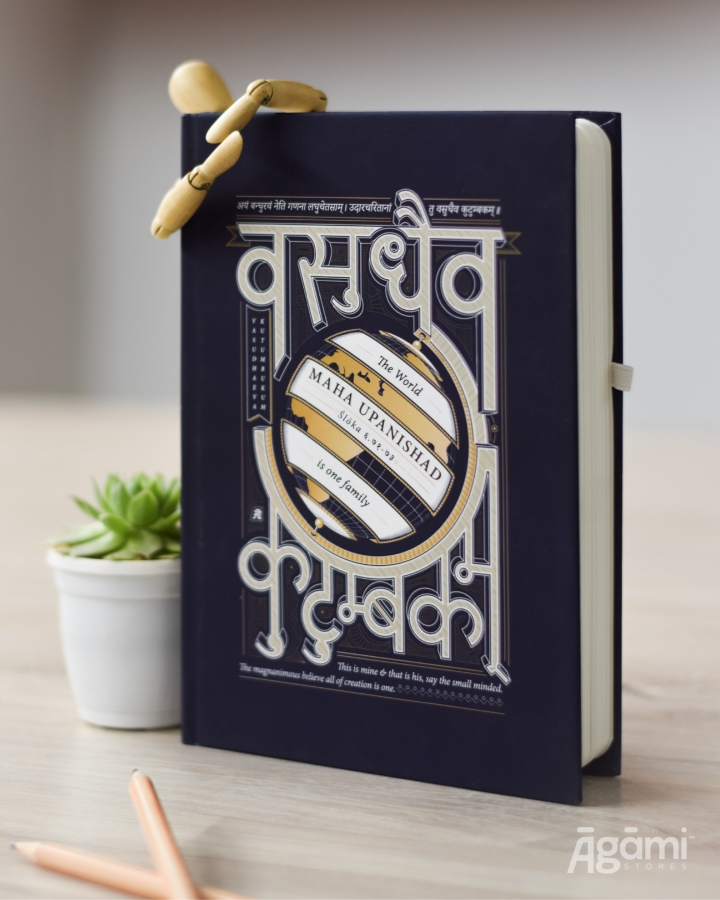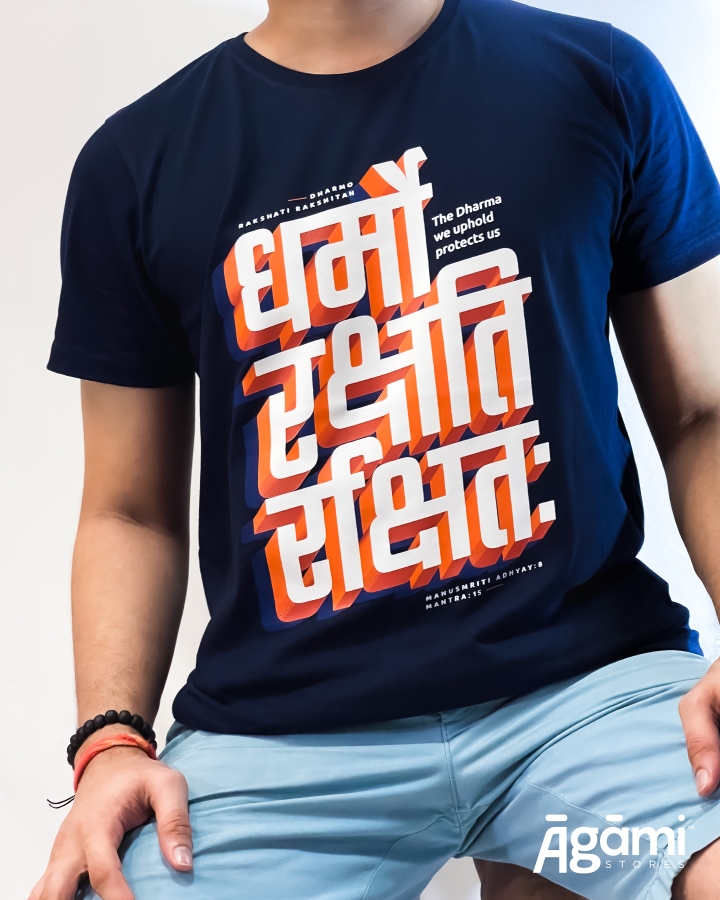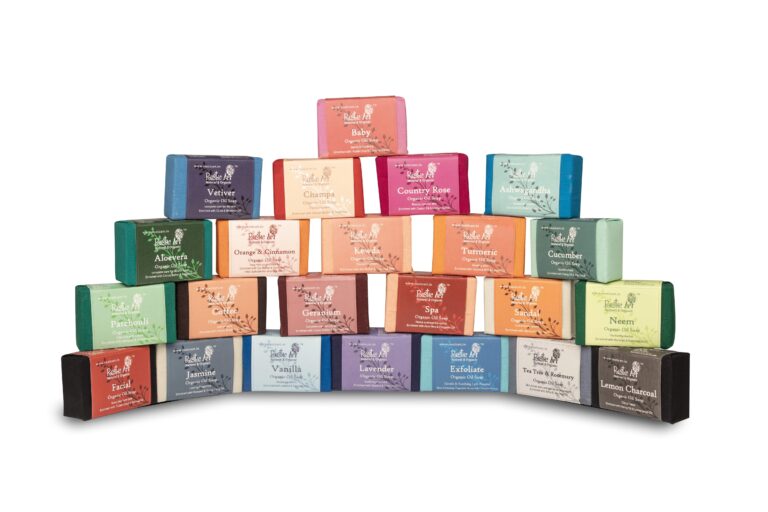Studio Āgāmi, a Sanatana Dharma based lifestyle brand, was founded by Tushar Diwan in Mumbai in 2021. Āgāmi presents ancient Indian knowledge & the eternal tenets of Sanātana Dharma. Sanatana Dharma literally translates to “the natural and eternal way to live”. Studio Āgāmi aims to contemporize it to address the new next generation of Indians and thus craft the next chapter in India’s rich cultural and spiritual heritage. Their products range for t-shirts, badges to even journals and mugs related to these teachings that people connect with.
The founder, Tushar Diwan, is a 28 year old visual designer & creative director by profession from Mumbai, India. He has done his graduation in Visual Communication (Graphic Design) from MIT Institute of Design – Pune, India (2012-17) and a masters in Creative Advertising from NABA- Milan, Italy (2018-19).
During his study tenure at MIT, he got opportunities to create art installations for IIT-B Mood Indigo & later for Coldplay’s first concert in Mumbai in 2016. Both required him to learn important team building skills. From there on, he went on to create art installations for Kala Ghoda 2018, Abu Dhabi Tourism, Parker Pens & Lamborghini in 2021 amongst several other design related projects.

Besides a keen interest in design and creativity, Tushar also has an affinity to stay updated on future technological trends, his current fixations being AI, Web3, Digital Communities etc. He looks at the tech with a curiosity to find its practical application in the things he does personally and professionally.
His easily discernible passion about India’s rich culture prompted his venture into the journey that led to the foundation of Studio Āgāmi. At a later stage of life he dreams to explore the possibility of being able to involve himself in mainstream public service and government, possibly in the sectors of tourism and design to be able to further contribute to nation building.
Follow our conversation with Mr. Tushar Diwan, founder of Studio Āgāmi.
My Journey to Build Studio Āgāmi
I’ve had the opportunity to experience various cultures through my travels to several countries for work, academics and leisure. However on an innate level, I felt a need to build a stronger connection with my own Indian heritage. Some podcasts and audiobooks began my encounter with Dharmic content and I found great practicality, depth & relevance in their approach towards subjects that are so basic and universal to all of humanity.
My belief in the teachings of the Sanatana Dharma truly strengthened during the pandemic as it personally helped me to deal with some of the challenges that the pandemic brought with itself. I became a fan of Sanatana Dharma and akin to Marvel and DC fans, I started looking for merchandise that expressed my spiritual side. However the designs were stereotypical and didn’t call out to me. This is when I stumbled on the idea of Studio Agami.

A committed follower of spiritual teachings has the stereotype of someone wearing a dhoti or a kurti and can cause a lot of preempted judgment in today’s world. Yet they might still want to connect with their spiritual identity in real-life and show the same. Agami tries to bridge this gap and create a sense of confidence. I realized that these brilliant teachings aren’t as common as they should be. This may be owing to the style, and channels used to communicate these teachings. Hence I started Agami as a lifestyle brand that can become a medium for a new generation of people to freely explore and express their Santani identity.
Also I don’t think there has ever been a better time than now for something like Agami owing to the positive trends that we are seeing in this space. People today are gradually becoming more proud and confident about their roots and culture than ever before and this is only going to increase. The success of films like Kantara and the boom of Indian cultural content in the digital space like never before, coupled with strong and conscious efforts of the Indian govt and authorities for revival of India’s cultural glory are what makes this such a great space to be in right now and in the time to come.
The Distinctive Identity of our Designs
How often do we see the older generation of Indians complain that the youth is disconnected from their sanskriti ? But how often do we try to really dissect and analyze why? The crux of the matter lies in the degradation of generational transfer of this knowledge. Over several generations efficient absorption and transfer of the core philosophy has been neglected. This has resulted in a disconnect and with the lack of a convincing reason for future generations to establish a connection with their heritage except “It’s our Tradition”, they have lost interest in it.
That’s what we are trying to do differently. Instead of simply expecting newer generations to take up their philosophical identity without understanding or having an interest in it first, we are trying to speak and communicate these ideas in a visual language and style that the current generation is already familiar with. We want our merchandise to become a gateway for a modern audience to reconnect with their philosophical roots.

Normally this kind of content is expressed in very traditional art styles that don’t fit into a contemporary lifestyle. Hence, a very clear distinction can be seen between a person’s Indian philosophical side and the other aspects of their regular life. We want to blur these hard lines which led us to choose a route that is uncommon in this space which is apparent from our choice of products and designs.
Unlike traditional attire and products, Agami products and designs fit perfectly into a contemporary person’s daily lifestyle giving them an opportunity to comfortably, freely and confidently express their Sanatani identity while retaining their existing personality.
Choosing a uniquely different path
I think one of the top challenges is that the path and objective we have chosen is slightly different from usual, over the years a certain kind of narrative has been built around this subject which has become the default outlook of a lot of people towards it. This needs a good deal of addressing and correction, which in itself is a major but an exciting and rewarding challenge.
Not only the current generation but ample people in the previous generation are also much in sync with the crux of the philosophy of Sanatana Dharma. While they follow traditions and rituals, a lack of a deeper understanding of the philosophy and how profound it is, has been a barrier in them effectively passing on this knowledge and insight to their children and grandchildren. This has resulted in the philosophy being reduced to only occasional rituals and traditions which might not be as appealing to a more globally connected younger generation if it is not accompanied by an effective communication of the scientific, logical and moral layers which form the actual backbone of this culture.

This is an interesting, yet a very rewarding challenge as it could possibly transform the way an entire generation and generations to come think, behave & live. It has the power to positively affect each and every aspect of generations of people to come thereby acting as a catalyst for a better, healthier & more confident India and thereby a better world.
Building bridges
Our key learnings uptill now have been that there exist very different kinds of groups of people. There are people who know nothing about Sanatana Dharma, then there are people who know about it in bits and pieces, often along with a lot of incorrect information and misconceptions and then there are people who know about it and are highly passionate about it. The need of the hour now is to effectively build bridges between these groups that can facilitate a movement, at a community level, of more and more people coming closer to the actual and authentic side of this spectrum.
Who is our target audience?
Our current market is Indian cities, towns and even villages. Sanatana Dharma is one of the key intangible aspects which connects every person residing or identifying with a Bhartiya culture. Especially the Indian youth who are gradually warming up to the strength of their Indian identity. Our core audience ranges from teens to even people in their thirties or forties. The younger generation would also be future parents who would want to raise and familiarize the next generation of Indians to be more conscious and aware about their Sanatani heritage.

Our typical customer is an Indian in their 20’s who is well connected, educated and aware about global trends. Someone who is media savvy, and at the same time open to expressing their inherent culture. They are just as proud about their spiritual identity as they are as confident about their academic and professional capabilities.
But we would not like to stop at that, one of our key drivers is to reach out and appeal to new audiences or people who are not yet aware about this kind of content and to inspire them to explore their spiritual side through this content.
Initiatives to create economically successful ecosystems
I think this is a brilliant initiative that helps us cover the final mile. Without a successful economic support for this ecosystem, it can never really thrive or achieve the success it rightly deserves. Becoming economically stable and successful is the only way to ensure that the people and organizations working in this space can focus wholeheartedly on generating high quality products and services. The general outlook towards this space needs to become more economically favorable. This is for current and future generations who may consider becoming a part of it and contributing to it with their expertise and skills. Hence we relate very closely to the goals of NICEorg. At Agami we ourselves are looking to build an economically successful enterprise that can lend support to people and initiatives working towards a common goal.
NICEorg wishes Studio Āgāmi the best of luck in their journey ahead!
If your cultural enterprise is in any of the five focus sectors and you would be interested in being featured, write to us at namaste@niceorg.in.




